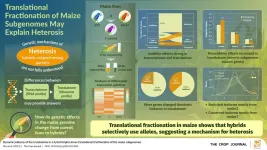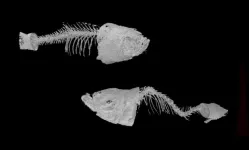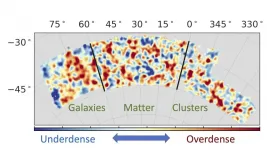(Press-News.org) Glycine regulates neuronal activity in the brain
Glycine is the smallest amino acid - one of the building blocks of proteins. It acts also as a neurotransmitter in the brain, enabling neurons to communicate with each other and modulating neuronal activity. Many researchers have focused on increasing glycine levels in synapses to find an effective treatment for schizophrenia. This could be done using inhibitors targeting Glycine Transporter 1 (GlyT1), a protein that sits in neuronal cell membranes and is responsible for the uptake of glycine into neurons. However, the development of such drugs has been hampered because the 3D structure of GlyT1 was not known.
To determine the structure of GlyT1, researchers at the Danish Research Institute of Translational Neuroscience (DANDRITE), which is part of the Nordic EMBL Partnership for Molecular Medicine, F. Hoffmann-La END
Structural biology opens new perspectives for treating psychiatric disorders
Scientists have determined the structure of Glycine Transporter 1; the finding could open new avenues for developing therapeutics for psychiatric disorders
2021-04-06
ELSE PRESS RELEASES FROM THIS DATE:
Gained in translation: Subgenome fractionation determines hybrid vigor in maize
2021-04-06
The adage goes, "Two is better than one." Well, that might be true for endeavors involving human heads, but when it comes to ears, hybrid maize tends to have a superior advantage over the parental stocks in most cases. This phenomenon, called hybrid vigor or "heterosis," has been used by agriculturalists across ages to create higher-yielding, more resistant varieties of maize all over the world.
But what are the factors contributing to the increased hybrid vigor of maize? Several different genetic models have been proposed to explain heterosis in varied ...
No pain, no gain in exercise for peripheral artery disease
2021-04-06
Pain will lessen over time
Results include longer distance and walking time
8.5 million people in U.S., 250 million worldwide, have PAD
CHICAGO --- No pain means no gain when it comes to reaping exercise benefits for people with peripheral artery disease (PAD), reports a new Northwestern Medicine study.
In people with peripheral artery disease, walking for exercise at an intensity that induces ischemic leg pain (caused by restricted blood flow) improves walking performance -- distance and length of time walking -- the study found. Walking at a slow pace that does not induce ischemic leg symptoms is no more effective than no exercise at all, the study showed.
This randomized trial is the first to show that a home-based walking exercise program ...
Gut microbiome plays role in autism
2021-04-06
Washington, D.C. - April 6, 2021 - A new study has demonstrated that autism spectrum disorder is related to changes in the gut microbiome. The findings are published this week in mSystems, an open-access journal of the American Society for Microbiology.
"Longitudinally, we were able to see that within an individual, changes in the microbiome were associated with changes in behavior," said principal study investigator Catherine Lozupone, PhD, a microbiologist in the Department of Medicine, University of Colorado, Anschutz Medical Campus, Aurora, Colorado. "If we are going to understand the link between the gut microbiome and autism, we need more collaborative efforts across different regions and ...
A novel form of cellular logistics
2021-04-06
Biophysicists from Ludwig-Maximilians-Universitaet (LMU) in Munich have shown that a phenomenon known as diffusiophoresis, which can lead to a directed particle transport, can occur in biological systems.
In order to perform their biological functions, cells must ensure that their logistical schedules are implemented smoothly, such that the necessary molecular cargoes are delivered to their intended destinations on time. Most of the known transport mechanisms in cells are based on specific interactions between the cargo to be transported and the energy-consuming motor ...
Screening for skin disease on your laptop
2021-04-06
The founding chair of the Biomedical Engineering Department at the University of Houston is reporting a new deep neural network architecture that provides early diagnosis of systemic sclerosis (SSc), a rare autoimmune disease marked by hardened or fibrous skin and internal organs. The proposed network, implemented using a standard laptop computer (2.5 GHz Intel Core i7), can immediately differentiate between images of healthy skin and skin with systemic sclerosis.
"Our preliminary study, intended to show the efficacy of the proposed network architecture, holds promise in the characterization of SSc," reports Metin Akay, John S. Dunn Endowed Chair Professor of biomedical engineering. ...
Alien raindrops surprisingly like rain on Earth
2021-04-06
WASHINGTON--Raindrops on other planets and moons are close to the size of raindrops on Earth despite having different chemical compositions and falling through vastly different atmospheres, a new study finds. The results suggest raindrops falling from clouds are surprisingly similar across a wide range of planetary conditions, which could help scientists better understand the climates and precipitation cycles of other worlds, according to the researchers.
Raindrops on Earth are made of water, but other worlds in our solar system have precipitation made of more unusual stuff. On Venus, ...
New perspective to understand and treat a rare calcification disease
2021-04-06
As part of an international collaboration, researchers from ELTE Eötvös Loránd University developed a new animal model to study a rare genetic disease that can lead to blindness at the age of 40-50. The new model could open up new perspectives in our understanding of this metabolic disease and will also help to identify new potential drug candidates, according to the recent study published in Frontiers in Cell and Developmental Biology.
Pseudoxanthoma elasticum (PXE) is a rare genetic disease with symptoms that usually manifest in adolescence or in early adulthood. The symptoms are caused by the appearance of hydroxyapatite crystal deposits in the subcutaneous connective tissue and retina ...
Dark Energy Survey physicists open new window into dark energy
2021-04-06
The universe is expanding at an ever-increasing rate, and while no one is sure why, researchers with the Dark Energy Survey (DES) at least had a strategy for figuring it out: They would combine measurements of the distribution of matter, galaxies and galaxy clusters to better understand what's going on.
Reaching that goal turned out to be pretty tricky, but now a team led by researchers at the Department of Energy's SLAC National Accelerator Laboratory, Stanford University and the University of Arizona have come up with a solution. Their analysis, published April 6 in Physical Review ...
For breastfeeding moms, COVID-19 vaccinations may also protect babies
2021-04-06
Nursing mothers who receive a COVID-19 vaccine may pass protective antibodies to their babies through breast milk for at least 80 days following vaccination, suggests new research from Washington University School of Medicine in St. Louis.
"Our study showed a huge boost in antibodies against the COVID-19 virus in breast milk starting two weeks after the first shot, and this response was sustained for the course of our study, which was almost three months long," said first author Jeannie Kelly, MD, assistant professor of obstetrics and gynecology. "The antibodies levels were still high at the end of our study, so the protection likely extends even longer."
Based ...
Accelerated cellular aging associated with mortality seen in depressed individuals
2021-04-06
Cells from individuals with Major Depressive Disorder (MDD) were found to have higher than expected rates of methylation at specific sites on their DNA, when compared to cells from healthy individuals without MDD, according to a study by a multidisciplinary team of UC San Francisco scientists, in collaboration with others. Methylation is a process by which DNA is chemically modified at specific sites, resulting in changes in the expression of certain genes. Methylation of particular sets of genes, called "DNA methylation clocks," typically change in predictable ways as people ...
LAST 30 PRESS RELEASES:
Tracing the quick synthesis of an industrially important catalyst
New software sheds light on cancer’s hidden genetic networks
UT Health San Antonio awarded $3 million in CPRIT grants to bolster cancer research and prevention efforts in South Texas
Third symposium spotlights global challenge of new contaminants in China’s fight against pollution
From straw to soil harmony: International team reveals how biochar supercharges carbon-smart farming
Myeloma: How AI is redrawing the map of cancer care
Manhattan E. Charurat, Ph.D., MHS invested as the Homer and Martha Gudelsky Distinguished Professor in Medicine at the University of Maryland School of Medicine
Insilico Medicine’s Pharma.AI Q4 Winter Launch Recap: Revolutionizing drug discovery with cutting-edge AI innovations, accelerating the path to pharmaceutical superintelligence
Nanoplastics have diet-dependent impacts on digestive system health
Brain neuron death occurs throughout life and increases with age, a natural human protein drug may halt neuron death in Alzheimer’s disease
SPIE and CLP announce the recipients of the 2025 Advanced Photonics Young Innovator Award
Lessons from the Caldor Fire’s Christmas Valley ‘Miracle’
Ant societies rose by trading individual protection for collective power
Research reveals how ancient viral DNA shapes early embryonic development
A molecular gatekeeper that controls protein synthesis
New ‘cloaking device’ concept to shield sensitive tech from magnetic fields
Researchers show impact of mountain building and climate change on alpine biodiversity
Study models the transition from Neanderthals to modern humans in Europe
University of Phoenix College of Doctoral Studies releases white paper on AI-driven skilling to reduce burnout and restore worker autonomy
AIs fail at the game of visual “telephone”
The levers for a sustainable food system
Potential changes in US homelessness by ending federal support for housing first programs
Vulnerability of large language models to prompt injection when providing medical advice
Researchers develop new system for high-energy-density, long-life, multi-electron transfer bromine-based flow batteries
Ending federal support for housing first programs could increase U.S. homelessness by 5% in one year, new JAMA study finds
New research uncovers molecular ‘safety switch’ shielding cancers from immune attack
Bacteria resisting viral infection can still sink carbon to ocean floor
Younger biological age may increase depression risk in older women during COVID-19
Bharat Innovates 2026 National Basecamp Showcases India’s Most Promising Deep-Tech Ventures
Here’s what determines whether your income level rises or falls
[Press-News.org] Structural biology opens new perspectives for treating psychiatric disordersScientists have determined the structure of Glycine Transporter 1; the finding could open new avenues for developing therapeutics for psychiatric disorders




